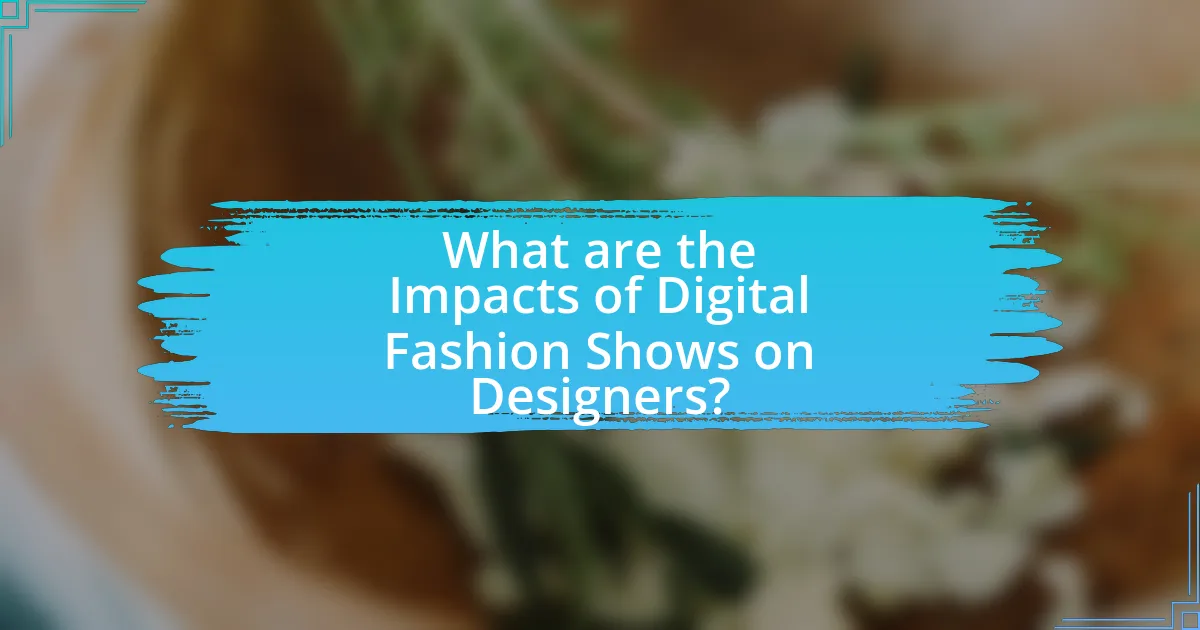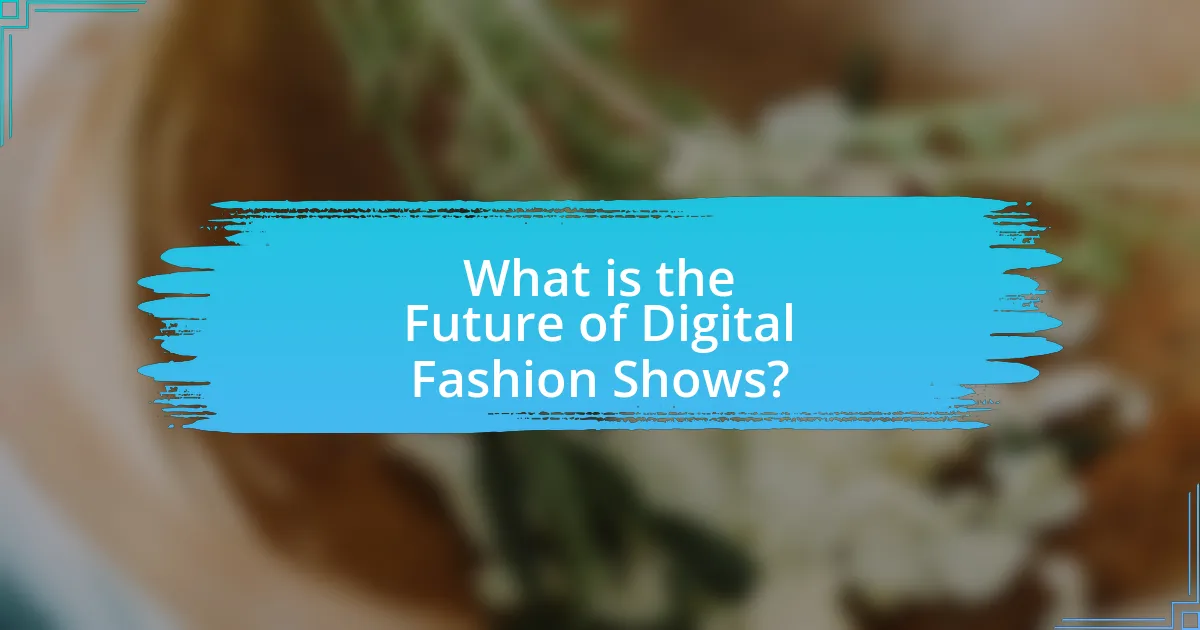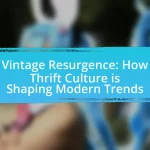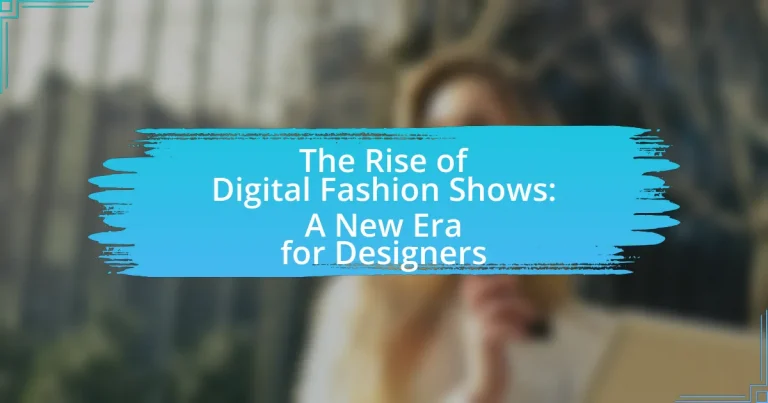Digital fashion shows represent a transformative shift in the fashion industry, utilizing advanced technologies such as augmented reality, virtual reality, and live streaming to present clothing collections to a global audience. Unlike traditional fashion shows, which are limited to physical venues and invite-only guests, digital formats enhance accessibility and interactivity, allowing designers to engage with viewers in real-time. The COVID-19 pandemic has accelerated the adoption of these virtual presentations, leading to increased visibility and reduced costs for designers, particularly emerging talents. This article explores the differences between digital and traditional fashion shows, the technologies involved, audience engagement strategies, and the future implications for designers in a rapidly evolving digital landscape.

What are Digital Fashion Shows?
Digital fashion shows are virtual presentations of clothing collections that utilize digital technology to showcase designs. These shows often feature 3D models, augmented reality, and immersive experiences, allowing designers to reach a global audience without the constraints of physical venues. The rise of digital fashion shows has been accelerated by the COVID-19 pandemic, which prompted many brands to adapt to online formats. According to a report by McKinsey & Company, the digital fashion market is expected to grow significantly, reflecting the increasing acceptance and demand for virtual experiences in the fashion industry.
How do Digital Fashion Shows differ from traditional fashion shows?
Digital fashion shows differ from traditional fashion shows primarily in their format and accessibility. Traditional fashion shows are physical events held in specific locations, often limited to invited guests, while digital fashion shows utilize online platforms to reach a global audience, allowing anyone with internet access to view the presentations. This shift has been accelerated by advancements in technology and the need for brands to adapt to changing consumer behaviors, particularly during the COVID-19 pandemic, which restricted in-person gatherings. Digital shows can incorporate interactive elements, such as virtual reality and augmented reality, enhancing viewer engagement compared to the static nature of traditional runway presentations.
What technologies are used in Digital Fashion Shows?
Digital fashion shows utilize technologies such as augmented reality (AR), virtual reality (VR), 3D modeling, and live streaming. AR enhances the viewer’s experience by overlaying digital elements onto the physical world, while VR creates immersive environments for showcasing collections. 3D modeling allows designers to create detailed virtual garments, enabling realistic visualizations before production. Live streaming technology facilitates real-time broadcasts of fashion shows to global audiences, expanding reach and engagement. These technologies collectively transform traditional fashion presentations into interactive and accessible experiences, reflecting the industry’s adaptation to digital advancements.
How do audience engagement strategies vary between formats?
Audience engagement strategies vary significantly between digital and traditional formats. In digital formats, strategies often leverage interactive elements such as live chats, polls, and social media integration to foster real-time participation, enhancing viewer involvement. For instance, during digital fashion shows, designers can utilize platforms like Instagram Live or YouTube to engage audiences through Q&A sessions, allowing immediate feedback and interaction. In contrast, traditional formats like in-person runway shows primarily rely on visual spectacle and exclusivity, where audience engagement is limited to passive observation, with minimal opportunities for interaction. This distinction highlights how digital formats prioritize interactivity and community-building, while traditional formats focus on presentation and brand prestige.
Why are Digital Fashion Shows becoming popular?
Digital fashion shows are becoming popular due to their ability to reach a global audience and reduce costs associated with traditional runway shows. These virtual events allow designers to showcase their collections online, eliminating geographical barriers and enabling viewers from around the world to participate. Additionally, digital fashion shows often require lower production costs, as they do not necessitate physical venues, travel, or large teams, making them more accessible for emerging designers. The COVID-19 pandemic accelerated this trend, as many in-person events were canceled, prompting the fashion industry to adapt to digital formats. According to a report by McKinsey & Company, the shift to digital platforms has been embraced by over 70% of fashion brands, highlighting the growing acceptance and popularity of this format.
What role does social media play in the rise of Digital Fashion Shows?
Social media significantly contributes to the rise of digital fashion shows by providing a platform for designers to reach a global audience instantly. This accessibility allows brands to showcase their collections to millions without the constraints of physical venues or traditional media coverage. For instance, during the COVID-19 pandemic, many fashion houses transitioned to digital formats, leveraging platforms like Instagram and YouTube to stream their shows live, which resulted in increased viewer engagement and participation. According to a report by McKinsey & Company, 75% of fashion executives believe that digital channels will be crucial for their business strategies moving forward, highlighting the importance of social media in shaping the future of fashion presentations.
How has the COVID-19 pandemic influenced this trend?
The COVID-19 pandemic has significantly accelerated the adoption of digital fashion shows as a primary platform for designers. With physical events restricted due to health guidelines, many fashion houses transitioned to virtual formats, allowing them to reach global audiences without geographical limitations. For instance, the 2021 Paris Fashion Week featured numerous digital presentations, showcasing collections online and attracting millions of viewers, a stark contrast to the limited attendance of traditional shows. This shift not only provided a solution during lockdowns but also highlighted the potential for increased accessibility and sustainability in the fashion industry, as digital formats reduce the carbon footprint associated with travel and physical setups.

What are the Impacts of Digital Fashion Shows on Designers?
Digital fashion shows significantly impact designers by enhancing their global reach and reducing costs associated with traditional runway shows. These virtual platforms allow designers to showcase their collections to a wider audience without geographical limitations, increasing visibility and potential sales. For instance, during the COVID-19 pandemic, many designers transitioned to digital formats, leading to a reported 30% increase in online engagement and sales for some brands. Additionally, digital shows eliminate expenses related to venue rentals, travel, and physical production, enabling designers to allocate resources towards creativity and innovation. This shift also fosters collaboration with technology, allowing for interactive and immersive experiences that can attract tech-savvy consumers.
How do Digital Fashion Shows affect the visibility of designers?
Digital fashion shows significantly enhance the visibility of designers by broadening their audience reach and providing a platform for global exposure. Unlike traditional runway shows, which are often limited to a select audience, digital formats allow designers to showcase their collections to millions online, increasing brand awareness and engagement. For instance, during the COVID-19 pandemic, brands like Balenciaga and Gucci utilized digital platforms to reach wider audiences, resulting in increased online traffic and social media engagement. This shift not only democratizes access to fashion but also allows emerging designers to compete on a global scale, as seen with platforms like Instagram and TikTok, where many new talents gain recognition.
What opportunities do Digital Fashion Shows create for emerging designers?
Digital fashion shows create significant opportunities for emerging designers by providing a global platform to showcase their collections without the constraints of traditional runway shows. These virtual events allow designers to reach a wider audience, including potential buyers, influencers, and media, which can lead to increased visibility and sales. For instance, during the COVID-19 pandemic, many designers utilized digital platforms to present their work, resulting in a 70% increase in online engagement compared to previous years. This shift not only democratizes access to fashion shows but also reduces costs associated with physical presentations, enabling emerging designers to invest more in their creative processes.
How can established designers leverage Digital Fashion Shows for brand growth?
Established designers can leverage Digital Fashion Shows for brand growth by utilizing innovative technology to reach a global audience, enhance engagement, and create immersive experiences. Digital platforms allow designers to showcase their collections to millions without geographical limitations, significantly increasing visibility. For instance, the 2021 Paris Fashion Week featured numerous digital shows that attracted over 1.5 million viewers online, demonstrating the potential for expanded reach. Additionally, interactive elements such as virtual reality and augmented reality can enhance viewer engagement, allowing consumers to experience the brand in a more personal and memorable way. This approach not only fosters a deeper connection with the audience but also drives online sales, as seen in the 2020 report by McKinsey, which indicated that brands utilizing digital shows saw a 30% increase in e-commerce sales post-event.
What challenges do designers face with Digital Fashion Shows?
Designers face several challenges with digital fashion shows, primarily related to technology, audience engagement, and brand representation. The reliance on technology can lead to issues such as platform instability, which can disrupt the viewing experience and affect the presentation of designs. Additionally, engaging an online audience poses difficulties, as designers must compete for attention in a crowded digital space, often lacking the immersive experience of physical shows. Furthermore, accurately representing the textures and colors of garments in a digital format can be challenging, potentially leading to misinterpretations of the designs. These challenges highlight the complexities designers must navigate in the evolving landscape of digital fashion shows.
How do designers adapt their creative processes for digital formats?
Designers adapt their creative processes for digital formats by integrating technology into their workflows, allowing for enhanced visualization and interactivity. This adaptation includes utilizing 3D modeling software to create virtual garments, which enables designers to visualize their creations in a digital space before physical production. Additionally, designers often employ digital platforms for collaboration, allowing real-time feedback and adjustments, which streamlines the design process. The shift to digital formats also encourages designers to consider user experience and engagement, leading to innovative presentations that leverage social media and virtual reality. This evolution reflects the industry’s response to changing consumer behaviors and the increasing importance of online presence in fashion marketing.
What are the potential pitfalls of relying on Digital Fashion Shows?
Relying on Digital Fashion Shows can lead to several potential pitfalls, including limited audience engagement and the risk of oversaturation. Digital formats may fail to replicate the immersive experience of physical shows, resulting in diminished emotional connection for viewers. Additionally, the ease of access to digital content can lead to an overwhelming amount of fashion shows, causing audience fatigue and reducing the impact of individual presentations. Furthermore, technical issues such as streaming failures or poor video quality can detract from the overall experience, potentially harming a brand’s reputation. These challenges highlight the need for careful planning and execution in the digital realm to maintain the effectiveness of fashion presentations.

What is the Future of Digital Fashion Shows?
The future of digital fashion shows is poised for significant growth and innovation, driven by advancements in technology and changing consumer behaviors. As brands increasingly adopt virtual platforms, they can reach wider audiences without geographical limitations, enhancing accessibility and engagement. For instance, the COVID-19 pandemic accelerated the shift towards digital formats, with major fashion weeks transitioning online, showcasing collections through live streams and immersive experiences. This trend is supported by data indicating that 67% of consumers prefer online shopping experiences, highlighting the demand for digital engagement in fashion. Additionally, the integration of augmented reality (AR) and virtual reality (VR) technologies is expected to enhance the viewer experience, allowing consumers to interact with designs in real-time. As sustainability becomes a priority, digital fashion shows also offer a more eco-friendly alternative by reducing the carbon footprint associated with traditional runway events.
How might technology evolve in Digital Fashion Shows?
Technology in digital fashion shows is likely to evolve through advancements in virtual reality (VR), augmented reality (AR), and artificial intelligence (AI). These technologies will enhance viewer engagement by creating immersive experiences that allow audiences to interact with fashion in real-time. For instance, VR can transport viewers to virtual runways, while AR can enable users to visualize clothing on themselves through their devices. Additionally, AI can analyze consumer preferences and trends, allowing designers to tailor collections more effectively. The integration of these technologies is supported by the growing trend of online shopping and the increasing demand for innovative marketing strategies in the fashion industry.
What innovations are on the horizon for virtual fashion experiences?
Innovations on the horizon for virtual fashion experiences include the integration of augmented reality (AR) and virtual reality (VR) technologies, which will allow consumers to interact with digital garments in immersive environments. These technologies enable users to visualize clothing on themselves through AR applications or experience fashion shows in VR settings, enhancing engagement and personalization. For instance, brands like Balenciaga and Gucci have already begun experimenting with these technologies, showcasing their collections in virtual spaces that mimic real-world environments. Additionally, advancements in artificial intelligence (AI) will facilitate personalized shopping experiences by analyzing user preferences and suggesting tailored outfits, further revolutionizing how consumers engage with fashion.
How could augmented reality change the way we experience fashion shows?
Augmented reality could revolutionize fashion shows by creating immersive experiences that allow viewers to interact with designs in real-time. This technology enables audiences to visualize clothing on themselves through virtual try-ons, enhancing engagement and personal connection to the garments. For instance, brands like Balenciaga have utilized AR to let users see their collections on digital avatars, demonstrating how AR can bridge the gap between physical and digital fashion. Additionally, AR can provide detailed information about fabrics and design processes, enriching the viewer’s understanding and appreciation of the artistry involved. This shift not only democratizes access to high-fashion events but also expands the reach of designers to global audiences, as seen in the rise of virtual fashion weeks during the pandemic.
What best practices should designers follow for successful Digital Fashion Shows?
Designers should prioritize high-quality visuals and engaging storytelling for successful digital fashion shows. High-resolution images and videos enhance the viewer’s experience, while a compelling narrative connects the audience emotionally to the collection. Additionally, incorporating interactive elements, such as live chats or polls, can increase audience engagement and participation. According to a report by McKinsey & Company, digital fashion shows can reach a global audience, making it essential for designers to optimize their content for various platforms, ensuring accessibility and compatibility. Furthermore, leveraging social media for promotion before and after the event can significantly boost visibility and audience reach, as evidenced by the increased engagement metrics seen in successful digital campaigns.
How can designers effectively market their Digital Fashion Shows?
Designers can effectively market their Digital Fashion Shows by leveraging social media platforms, influencer partnerships, and targeted digital advertising. Social media channels like Instagram and TikTok allow designers to showcase their collections to a broad audience, with statistics indicating that 54% of consumers use social media to research products before making a purchase. Collaborating with influencers can amplify reach, as influencers often have dedicated followings that trust their recommendations. Additionally, targeted digital advertising can help designers reach specific demographics, enhancing visibility and engagement. According to a report by Statista, digital advertising spending is projected to reach $645 billion globally by 2024, highlighting the importance of this strategy in reaching potential customers effectively.
What strategies can enhance viewer engagement during Digital Fashion Shows?
Interactive elements such as live polls, Q&A sessions, and augmented reality features can significantly enhance viewer engagement during Digital Fashion Shows. These strategies allow viewers to actively participate in the experience, making them feel more connected to the event. For instance, incorporating live polls can provide immediate feedback on designs, while Q&A sessions enable direct interaction with designers, fostering a sense of community. Augmented reality features can allow viewers to visualize clothing in their own space, increasing interest and investment in the showcased items. According to a study by the Fashion Institute of Technology, events that incorporate interactive elements see a 30% increase in viewer retention and satisfaction, demonstrating the effectiveness of these strategies in enhancing engagement.

















